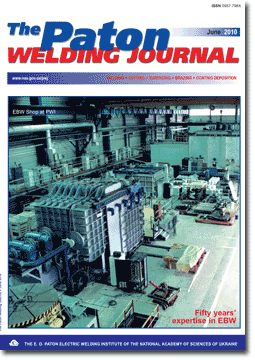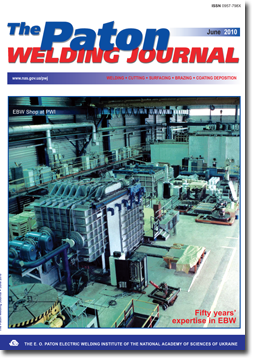| 2010 №06 (10) | 2010 №06 (02) |

TPWJ, 2010, #6, 2-9 pages
MODEL OF THE PROCESSES OF HEAT, MASS AND CHARGE TRANSFER IN THE ANODE REGION AND COLUMN OF THE WELDING ARC WITH REFRACTORY CATHODE
Journal The Paton Welding Journal
Publisher International Association «Welding»
ISSN 0957-798X (print)
Issue № 6, 2010 (June)
Pages 2-9
Authors
I.V. KRIVTSUN1, V.F. DEMCHENKO1 and I.V. KRIKENT2
1E.O. Paton Electric Welding Institute, NASU, Kiev, Ukraine
2Dneprodzerzhinsk State Technical University, Dneprodzerzhinsk, Ukraine
Abstract
The main difference of the proposed mathematical model of the welding arc from the known ones describing the atmospheric-pressure arcs is allowance for the multi-component composition of the arc plasma, which is caused by evaporation of the anode metal and convective diffusion of metal vapours in the arc column. The model can be used for numerical analysis of thermal, gas-dynamic and electromagnetic characteristics of the arc plasma in inert-gas tungstenelectrode and plasma welding, as well as for modelling of thermal and dynamic effects of the arc on the weld pool surface.
Keywords: tungsten-electrode welding, plasma welding, electric arc, arc column, multi-component plasma, anode region, anode potential drop, mathematical model
Received: ??.??.??
Published: 28.06.10
References
1. Hsu, K.S., Etemadi, K., Pfender, E. (1983) Study of the free-burning high-intensity argon arc. J. of Appl. Phys., 54(3), 1293-1301.
2. Hsu, K.S., Pfender, E. (1983) Two-temperature modeling of the free-burning high-intensity arc. Ibid., 54(8), 4359-4366.
3. Engelsht, V.S., Gurovich, V.Ts., Desyatkov, G.A. et al. (1990) Low-temperature plasma. Vol. 1: Theory of electric arc column. Novosibirsk: Nauka.
4. Zhu, P., Lowke, J.J., Morrow, R. et al. (1995) Prediction of anode temperatures of free burning arcs. J. Phys. D: Appl. Phys., 28, 1369-1376.
5. Jenista, J., Heberlein, J.V.R., Pfender, E. (1997) Numerical model of the anode region of high-current electric arcs. IEEE Transact. on Plasma Sci., 25(5), 883-890.
6. Lowke, J.J., Morrow, R., Haidar, J. (1997) A simplified unified theory of arcs and their electrodes. J. Phys. D: Appl. Phys., 30, 2033-2042.
7. Haidar, J. (1999) Non-equilibrium modeling of transferred arcs. Ibid., 32, 263-272.
8. Sansonnets, L., Haidar, J., Lowke, J.J. (2000) Prediction of properties of free burning arcs including effects of ambipolar diffusion. Ibid., 33, 148-157.
9. Fan, H.G., Kovacevic, R. (2004) A unified model of transport phenomena in gas metal arc welding including electrode, arc plasma and molten pool. Ibid., 37, 2531-2544.
10. Nishiyama, H., Sawada, T., Takana, H. et al. (2006) Computational simulation of arc melting process with complex interactions. ISIJ Int., 46(5), 705-711.
11. Hu, J., Tsai, H.L., (2007) Heat and mass transfer in gas metal arc welding. Pt 1: The arc. Int. J. of Heat and Mass Transfer, 50, 833-846.
12. Masquere, M., Freton, P., Gonzalez, J.J. (2007) Theoretical study in two dimensions of the energy transfer between an electric arc and an anode material. J. Phys. D: Appl. Phys., 40, 432-446.
13. Li He-Ping, Benilov, M.S. (2007) Effect of a near-cathode sheath on heat transfer in high-pressure arc plasmas. Ibid., 2010-2017.
14. Tanaka, M., Yamamoto, K., Tashiro, S. et al. (2008) Metal vapour behaviour in gas tungsten arc thermal plasma during welding. Welding in the World, 52(11/12), 82-88.
15. Benilov, M.S. (2008) Understanding and modeling plasmaelectrode interaction in high-pressure arc discharges: A review. J. Phys. D: Appl. Phys., 41, 30.
16. Mojzhes, B.Ya., Nemchinsky, V.A. (1972) To the theory of high-pressure arc at refractory cathode. Zhurnal Teoret. Fiziki, 42(5), 1001-1009.
17. Mojzhes, B.Ya., Nemchinsky, V.A. (1973) To the theory of high-pressure arc at refractory cathode. Pt 2. Ibid., 43(11), 2309-2317.
18. Zhukov, M.F., Kozlov, N.P., Pustogarov, A.V. et al. (1982) Near-electrode processes in arc discharges. Novosibirsk: Nauka.
19. Wendelstorf, J., Simon, G., Decker, I. et al. (1997) Investigation of cathode spot behaviour of atmospheric argon arcs by mathematical modeling. In: Proc. of 12th Int. Conf. on Gas Discharges and Their Applications (Germany, Greifswald, 1997). Vol. 1, 62-65.
20. Nemchinsky, V.A., Perets, L.N. (1977) Near-anode layer of high-pressure high-current arc. Zhurnal Teoret. Fiziki, 47(9), 1868-1875.
21. Dinulescu, H.A., Pfender, E. (1980) Analysis of the anode boundary layer of high intensity arcs. J. of Appl. Phys., 51(6), 3149-3157.
22. Krivtsun, I.V. (2001) Model of evaporation of metal in arc, laser and laser-arc welding. The Paton Welding J., 3, 2-9.
23. Dyuzhev, G.A., Nemchinsky, V.A., Shkolnik, S.M. et al. (1983) Anode processes in high-current arc discharge. Khimiya Plazmy, 10, 169-209.
24. Sanders, N.A., Pfender, E. (1984) Measurement of anode falls and anode heat transfer in atmospheric pressure high intensity arcs. J. of Appl. Phys., 55(3), 714-722.
25. Baksht, F.G., Dyuzhev, G.A., Mitrofanov, N.K. et al. (1973) Probe measurements in low-temperature dense plasma at high ionization degrees. Zhurnal Teoret. Fiziki, 43(12), 2574-2583.
26. Chen, F. (1967) Electric probes. In: Diagnostics of plasma. Moscow: Mir.
27. Griem, H.R. (1962) High-density correction in plasma spectroscopy. Phys. Rev., 128, 997-1001.
28. Knight, Ch.J. (1979) Theoretical modeling of rapid surface vaporization with back pressure. AIAA J., 17(5), 519-523.
29. Arutyunyan, R.V., Baranov, V.Yu., Bolshov, L.A. et al. (1989) Effect of laser radiation on materials. Moscow: Nauka.
The cost of subscription/purchase order journals or individual articles
| Journal/Currency | Annual Set | 1 issue printed |
1 issue |
one article |
| TPWJ/USD | 384 $ | 32 $ | 26 $ | 13 $ |
| TPWJ/EUR | 348 € | 29 € | 24 € | 12 € |
| TPWJ/UAH | 7200 UAH | 600 UAH | 600 UAH | 280 UAH |
| AS/UAH | 1800 UAH | 300 UAH | 300 UAH | 150 UAH |
| AS/USD | 192 $ | 32 $ | 26 $ | 13 $ |
| AS/EUR | 180 € | 30 € | 25 € | 12 € |
| SEM/UAH | 1200 UAH | 300 UAH | 300 UAH | 150 UAH |
| SEM/USD | 128 $ | 32 $ | 26 $ | 13 $ |
| SEM/EUR | 120 € | 30 € | 25 € | 12 € |
| TDNK/UAH | 1200 UAH | 300 UAH | 300 UAH | 150 UAH |
| TDNK/USD | 128 $ | 32 $ | 26 $ | 13 $ |
| TDNK/EUR | 120 € | 30 € | 25 € | 15 € |
AS = «Automatic Welding» - 6 issues per year;
TPWJ = «PATON WELDING JOURNAL» - 12 issues per year;
SEM = «Electrometallurgy Today» - 4 issues per year;
TDNK = «Technical Diagnostics and Non-Destructive Testing» - 4 issues per year.


